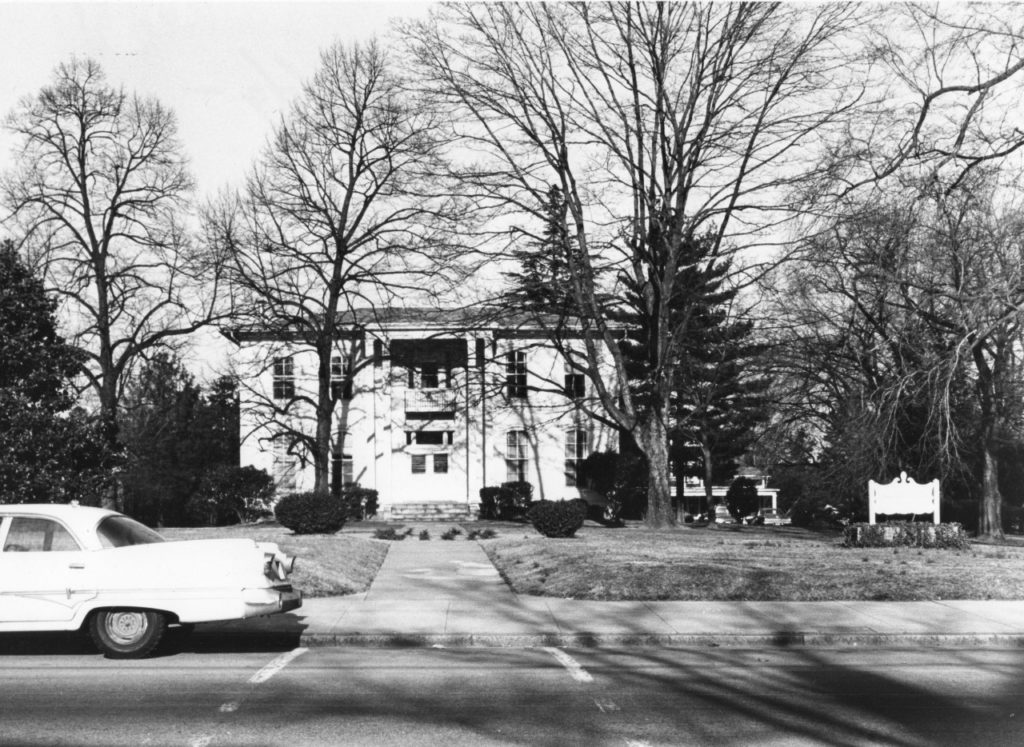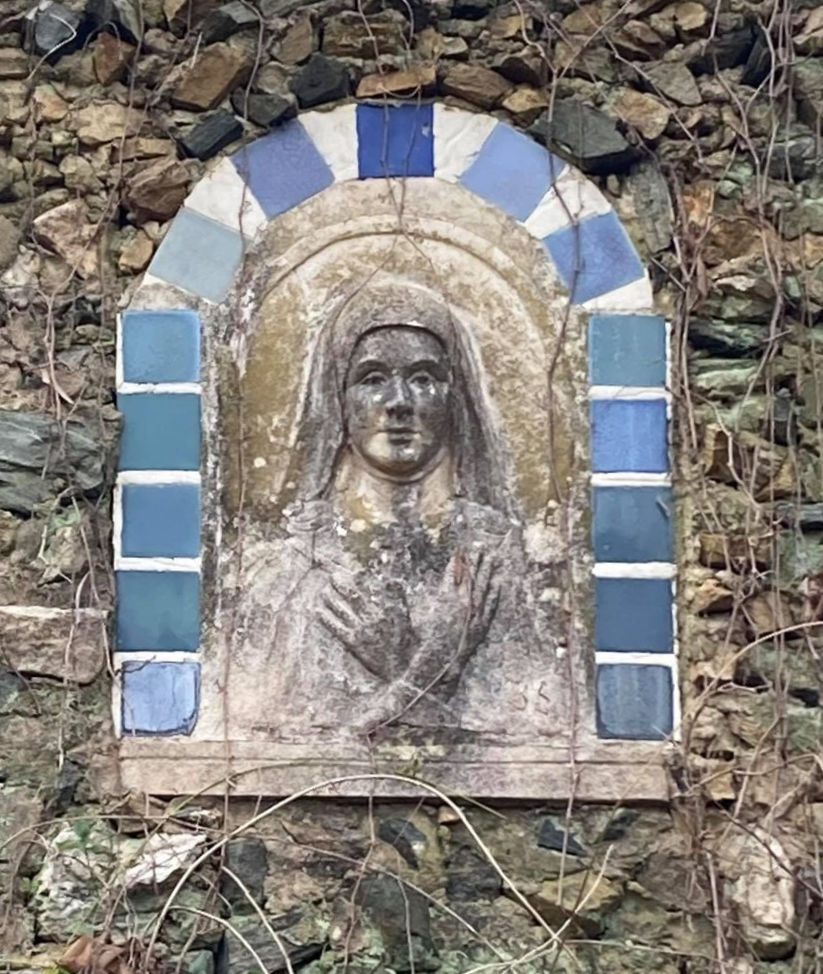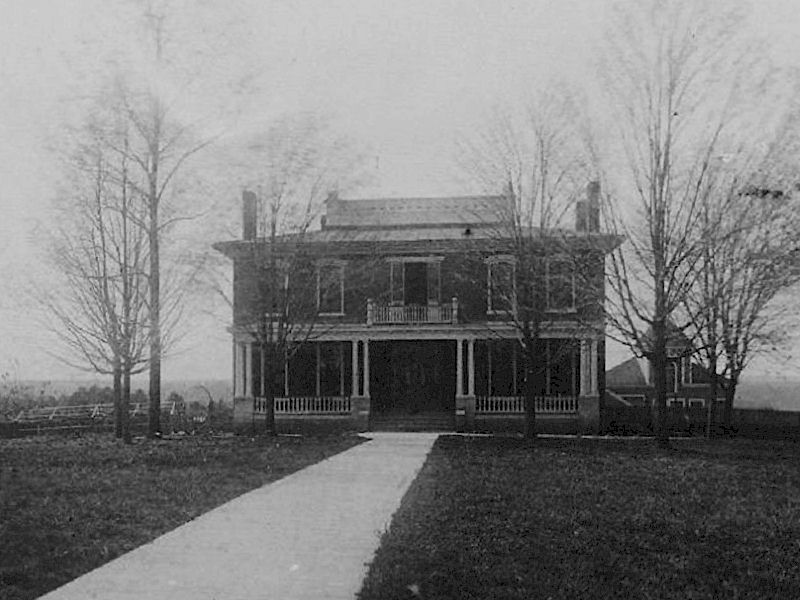William Crumpton was born in Lynchburg, Virginia in 1811 and arrived in Danville in 1868. Having acquired a lot on the old Salisbury Road, he hired William E. Boisseau and James E. Perkins to build a house there. In the contract, Mr. Crumpton specified that the house should be brick, “on land newly purchased by Crumpton between the property of John F. Ficklen and John W. McKinley.” The structure was to be fifty feet wide in front with one and a half foot thick walls and four chimneys. It was described by Danvillians as being out in the woods, on the unpaved country road (now 344 West Main Street). More than that, the house was said to be haunted.
Though existing historical records have yet to confirm such a story is true, it was said that the Crumptons had a son who had gone mad, and so, rather than locking him up in an institution they kept him locked up in a small room in the basement. Institutions in the Victorian era were barbaric places of cruelty and experimentation where unproven cures were tried upon unwilling patients and where those who could not abide by the norms (or who were simply no longer wanted) could be disposed of legally and, at least for the standards of the day semi-ethically. The nearest institution to Danville was the Virginia Sate Colony, later the Lynchburg Training School, which gained infamy as the home of the American Eugenics movement. (You can read more about that here.)
 If William had a son who was mentally incapacitated, he was not the only one with troubles. It seemed some sort of madness ran in the family. At least the family seemed to be struck with a particularly avaricious streak of bad luck. William’s eldest son, Robert, grew up to have a family of his own, and his relationship with his own children was clearly strained. How parents managed discipline in the late 1800’s sometimes bordered on brutality. A little rough treatment was good for a man, after all, as it “toughened him up.” Whatever the custom may have been in the Crumpton family, by the time Robert’s son had grown the tables had turned. The culmination came in 1912 when Robert Crumpton, at the age of 75, was beaten with a horsewhip by his son, William Ely Crumpton, and grandson, William Cleveland Crumpton. It apparently happened on more than one occasion, too, as an informant to the case later indicated this sort of violence was not unusual. On this occasion, however, the incident proved fatal. If it had not resulted in a criminal case, no one likely would ever have known of it. Even on Robert’s death certificate, the cause of death was attributed to dysentery, possibly the result of a secondary infection from the wounds he’d received.
If William had a son who was mentally incapacitated, he was not the only one with troubles. It seemed some sort of madness ran in the family. At least the family seemed to be struck with a particularly avaricious streak of bad luck. William’s eldest son, Robert, grew up to have a family of his own, and his relationship with his own children was clearly strained. How parents managed discipline in the late 1800’s sometimes bordered on brutality. A little rough treatment was good for a man, after all, as it “toughened him up.” Whatever the custom may have been in the Crumpton family, by the time Robert’s son had grown the tables had turned. The culmination came in 1912 when Robert Crumpton, at the age of 75, was beaten with a horsewhip by his son, William Ely Crumpton, and grandson, William Cleveland Crumpton. It apparently happened on more than one occasion, too, as an informant to the case later indicated this sort of violence was not unusual. On this occasion, however, the incident proved fatal. If it had not resulted in a criminal case, no one likely would ever have known of it. Even on Robert’s death certificate, the cause of death was attributed to dysentery, possibly the result of a secondary infection from the wounds he’d received.
It would be hoped that the Crumpton family, perhaps by some act of heroism, might eventually free themselves of the curse that seemed to haunt them. Just such an example of heroism is found in the example of Kenneth Crumpton (a descendent of William who lived on Green Street) who, during World War I, rescued a young soldier by the name of Archibald Roosevelt, the son of former president Theodore Roosevelt (read about that story here).
In 1923, tragedy struck again when another of Robert’s grandsons became the victim of an accidental drowning. Eighteen-year-old Luther Crumpton had gone swimming with a group of friends in a pond near Pelham, North Carolina, where they were used to swim with their Boy Scout troop. While the main body of the group remained near the shore, Crumpton and his cousin, Haywood Cook, took a raft out and were nearing the opposite bank when it appeared Crumpton suddenly lost balance and tilted off the raft into the water. He went down once, came up again, and then proceeded to swim toward the bank. It soon became apparent, however, that he was struggling to stay above the water. Cook went to his rescue, but seizing him, Crumpton, so desperate to be rescued, only managed to pull his cousin down with him. Cook reluctantly freed himself, and Crumpton went under, not to be found again until his body was recovered some thirty minutes later.

After the Crumptons, the house at 344 West Main Street stood vacant for a time, though it was occasionally occupied by vagrants. In 1901, Louis Puryear made a temporary home in the house while he built a home of his own across the street.
The home was later purchased by Walter Wood Waddill, a Danville printer and bookseller. It was he who built the carriage house which is still standing today (see featured image at the heading of this post). The Wadills remained in the house for three generations and during that time watched the city’s expansion as it stretched out to Schoolfield. In 1952, a year after the death of Mr. Waddill Jr., his widow sold the house to Sacred Heart Catholic Church who used the building as a school for first to eighth graders.
 In 1966, Averett College purchased the property and built the Mary B. Blount Library directly in front of the house. In 1971, during a wave of demolition and destruction of Danville’s historic homes, it was decided the house should be sacrificed to make way for parking behind the new library.
In 1966, Averett College purchased the property and built the Mary B. Blount Library directly in front of the house. In 1971, during a wave of demolition and destruction of Danville’s historic homes, it was decided the house should be sacrificed to make way for parking behind the new library.
In May of 1971, just weeks before the old Crumpton house came down, Jewelyn Bowman Crumpton, wife of John Wesley Crumpton, great grandson of Robert Crumpton, died unexpectedly of a self-inflicted gunshot wound.
We can only hope the curse has subsided for the Crumpton family who contributed so much to Danville’s early development and that those who suffered so much in this life may now rest in peace.
Sources:
The Register, Danville, Virginia; 8 July 1971, “Century-Old Crumpton-Waddill Home Being Razed in Expansion of Averett College”
The Union Republican, Winston-Salem; 12 Dec 1912, “A Dastardly Act”
The Bee, Danville, Virginia; 25 Jun 1923; “Boy Drowns Sunday While Swimming in Pond Near Pelham”
The Bee, Danville, Virginia; 20 May 1971; “Mrs. Crumpton, Suicide Victim, Rites Tomorrow”
1870 US Census
Images of Crumpton-Waddill Home courtesy of Clara Fountain

Wow….